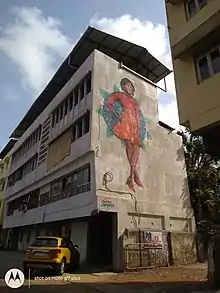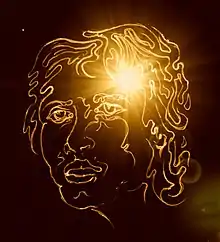Sita Valles
Sita Maria Dias Valles (Cabinda, 23 August 1951 – Luanda, c. 1 August 1977) was a political activist, doctor and member of the Portuguese Communist Party, in charge of the União dos Estudantes Comunistas (or Communist Students' League). She was tortured and brutally murdered following the events of May 1977, presumably in August 1977 in Luanda, Angola. Leonor Figueiredo, an author whose work on Sita Valles has been published in Portuguese and English, says Valles had a very short but intense life: her conscience objected to the injustices that ruled the world, and turned into a political whirlwind.[1] Sita Valles has been called "A 'Passionária' de Angola" (The Passionaria of Angola).[2]

Early life
Born in 1951, Dias Valles was the daughter of Edgar Francisco da Purificação Valles and Maria Lúcia Dias Valles, a Goan couple based in what was then Portuguese-ruled Africa. Sita grew up in the Angolan capital Luanda in a prosperous family of Goan origin.
Seen in her time as pretty, intelligent and charming, she was also bold and independent, according to her biographers. She began her political activity on joining the Faculty of Medicine of Luanda, on being connected with Maoist groups.
Reviewer Adolfo Mascarenhas describes her from a photograph he encountered in her 2018 English-language biography: "...there she was, more standing than leaning on a Morris Minor sedan of the 1950’s, tallish, determined jaw, crossed legs, a shortish white skirt topped by a polar necked long sleeved blouse."[3]
When she continued her studies in Lisbon, from 1971, she became part of the network of Communist militants and in the União dos Estudantes Comunistas. There, she would grow into one of the prominent figures next only to Zita Seabra.
Thomas Manuel argues that the story of Sita Valles crosses three countries and three continents: "If stories have shapes, this one lies over the sphere of the Earth like a triangle. The three vertices or points of this triangle lie on three different continents: one in India, one in Angola and one in Portugal. But the lines that join these points, that form these vertices, traverse not just space but time."[4]
Role following the Carnation Revolution

At the time of the Carnation Revolution of April 25, 1974, which also erupted in Angola following the overthrow of the Salazar dictatorship in colonial Portugal, Dias Valles was in Moscow participating in a congressthere. She decided to return to Angola in the summer of 1975 to participate in the revolution
In Luanda she was considered to be part of the ideologically more-orthodox wing of the People's Movement for the Liberation of Angola (MPLA), seen as pro-Soviet, which was directed by Nito Alves and José Van-Dunem. By 1976, Alves was the new MPLA government's interior minister while Van-Dunem, an ex-political prisoner and a key political commissar in the army. Sita Valles became "a leading functionary in the government’s Department of Mass Organization".[5]
Mascarenhas describes the couple thus:
‘Alves Nito’ was the nom de guerre of Bernando Alves Baptista; a young black Angolan born in 1945. Nito and Sita were particularly articulated and could talk impromptu on various issues hindering development. Their very virtues became their death sentence. Nito was a fast thinker and an analyst and rose rapidly up the ranks to become a member of the Central Committee of the MPLA and a Minister in independent Angola.[3]
In 1977, Dias Valles married Van-Dunem and had a son with him.
Death
Following Angola's independence, Alves took the helm of a new political movement within the People's Movement for the Liberation of Angola known as Fraccionismo; this movement had ruled the country since the independence of Angola. This movement surfaced as a difference of opinion that arose in the very heart of the MPLA, after the independence of Angola, from President Agostinho Neto.
In Luanda, what was said to be an attempted coup d'etat was launched on 27 May 1977. The attempt was foiled due to the support of the Cuban Revolutionary Armed Forces, then stationed in Angola. Alves, van Dunem and Dias Valles were deposed from their official positions.[5] The attempted coup was followed by a period of two years of bloody pursuit of (real and supposed) followers and sympathizers of Nito Alves leading to thousands of killings — though it is open to question how far the attempted coup itself was the cause of this pursuit and how far exaggerated accounts of the event were used to legitimate a purge of "an untold number of tiresome critics".[5]
Dias Valles was among those killed in this period. She was accused, without the right of contradiction, of being one of the brains of the alleged putsch of May 27, 1977. She is thought to have been shot in August of that year. According to Leonor Figueiredo,
It is said that Sita Valles was shot at five in the morning of August 1, 1977. One shot on each leg, one shot on each arm. The body fell into the ditch that had been previously dug, before the deadly firing. Of what remained of Sita, after the torture and the orgy of rape by the men of the Angola Information and Security Directorate (DISA), the regime's political police. A tractor flattened the ground. It is also said that the beautiful, elegant and intelligent communist of Goan origin -- a Portuguese with an African heart -- remained rebellious until the last moment. She said she was not afraid and that the sooner they killed her the better. By refusing to be blindfolded, she forced the snipers of the firing squad to meet her gaze before pulling the trigger."[2]
Attempts to correct the record
As of September 2020, the BBC carried an interview with the son of Sita Valles.[6] In the Newshour Sounds programme titled My parents were killed in Angola's secret massacre, the BBC reports:
A massacre in Angola that followed a split in the governing MPLA party not long after independence has been shrouded in secrecy and fear for more than four decades. But some of those affected are coming together to demand answers. João Ernesto Van Dunem was a three-month-old baby when his parents disappeared. He's been speaking to the BBC's James Menendez.
Following the translation of a biography on her life in her native region of Goa in 2018, there has been an interest there in her life. Pamela D'Mello writes in Scroll.in[7]
Before Goa’s liberation from Portuguese rule in 1961, its citizens would freely move to other colonies of the empire, including to African enclaves of Mozambique, Angola and Cape Verde. While most migrants and their children steered down conventional life paths, a few stood out for their distinctive work – like joining the liberation struggles in their adopted lands. From the shadowy pages of history, one such narrative has wound its way back to relate the valiant, contentious and tragic story of Left-wing revolutionary Sita Valles, an ethnic Goan-Indian who was born in Angola, where her Goan parents had migrated for work.
There have been hopes expressed that the new Angola government might "make admends".[3]
In 2018 in Goa, the Goa former minister Alina Saldanha, has been quoted as saying: "Sita, a great human being who lived her life fearlessly to ensure a more just society, especially for the downtrodden and the underprivileged. Sita Valles and my late husband Matanhy Saldanha were closely related: the similarity in their thought processes on some aspects of their life and the deep love for their respective lands is both striking and amazing."[3]
Biographies and studies
- Leonor Figueiredo, Sita Valles: Revolucionária, Comunista até à Morte (Alêtheia Editores, 2014) [translated as Sita Valles: A Revolutionary until Death by David Addison Smith (Goa 1556, 2018). The Portuguese author, a journalist since 1981, formerly with the Correio da Manhã till the end of the 1980s, and then for 21 years on the editorial board of the Diário de Notícias till January 2009.[8][9]
- Leonor Figueiredo, Secret Files of the Decolonization of Angola (Alêtheia Editores, 2009). This study investigated, gathered evidences, and looked for decades-old memories of Valles, José Van-Dunem, Nito Alves and an unknown number of victims which is believed to have probably exceeded 20,000. The study records a brutal history which had grown into a myth for a generation.
References
- Leonor Figueiredo, Sita Valles: Revolucionária, Comunista até à Morte (Alêtheia Editores, 2014).
- "A "Passionária" de Angola". cc3413. Retrieved 27 February 2017.
- Magazine, AwaaZ. "SITA VALLES - A Revolutionary Until Death - AwaaZ Magazine". www.awaazmagazine.com. Retrieved 2020-10-01.
- Manuel, Thomas (2019-03-25). "Sita Valles in Angola on the 27th of May 1977". 3 Quarks Daily. Retrieved 2020-10-01.
- Saul, John. ""When Freedom Died" in Angola: Alves and After". Africa Files. Retrieved 27 February 2017.
- "Newshour - My parents were killed in Angola's secret massacre - BBC Sounds". www.bbc.co.uk. Retrieved 2020-10-01.
- D’Mello, Pamela. "The Goan-origin woman who fought for Angola's freedom and was killed by its first government". Scroll.in. Retrieved 2020-10-01.
- "Book on life of a revolutionary Goan to be launched at GALF". The Goan Everyday. Dec 7, 2018. Retrieved Dec 10, 2018.
- Machado, Christine (Dec 6, 2018). "The tale of an unknown revolutionary". The Navhind Times. Retrieved 2018-12-11.
External links
- Purga em Angola, by Dalila Cabrita Mateus
- Biografia de Sita Valles revela mulher que morreu de olhos abertos perante pelotão de fuzilamento
- Sita Vales, protagonista do “27 de Maio” – In memorium
- A revolução perdida de Sita Valles
- Zita Seabra on Sita Valles
- Para além da morte trágica de Sita Valles (publico.pt)
- Sita Valles, on Gini.com
- Link to book on the publisher's website